统计学课件(英文)
合集下载
商务统计学英文课件 (7)
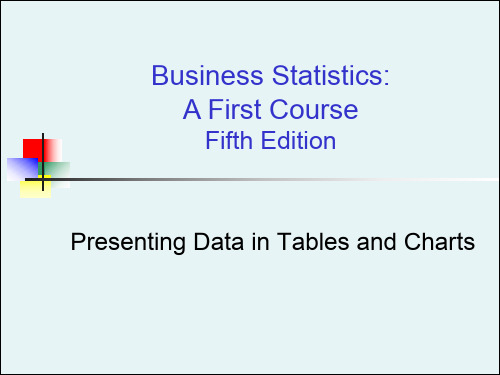
Percentage
15 30 25 20 10 100
Tabulating Numerical Data: Cumulative Frequency
Data in ordered array:
12, 13, 17, 21, 24, 24, 26, 27, 27, 30, 32, 35, 37, 38, 41, 43, 44, 46, 53, 58
n Bar charts and Pie charts are often used for categorical data
n Length of bar or size of pie slice shows the frequency or percentage for each category
§ To determine the width of a class interval, you divide the range (Highest value–Lowest value) of the data by the number of class groupings desired.
Organizing Numerical Data: Frequency Distribution Example
Organizing Numerical Data: Frequency Distribution Example
§ Sort raw data in ascending order:
12, 13, 17, 21, 24, 24, 26, 27, 27, 30, 32, 35, 37, 38, 41, 43, 44, 46, 53, 58
Organizing Categorical Data: Pareto Chart
《统计学基础(英文版·第7版)》教学课件les7e_ppt_04_02 (1)

Chapter 4
Discrete Probability Distributions
Copyright 2019, 2015, 2012, Pearson Education, Inc.
1
Chapter Outline
• 4.1 Probability Distributions • 4.2 Binomial Distributions • 4.3 More Discrete Probability Distributions
P(x)
nCx pxqnx
n!
pxqnx
(n x)!x!
• n = number of trials
• p = probability of success
• q = 1 – p probability of failure
• x = number of successes in n trials
surgeries)
.
Copyright 2019, 2015, 2012, Pearson Education, Inc.
9
Example: Identifying and Understanding Binomial Experiments
Decide whether each experiment is a binomial experiment. If it is, specify the values of n, p, and q, and list the possible values of the random variable x. If it is not, explain why.
n = 3, p = 190, q = 110, and x = 2.
Discrete Probability Distributions
Copyright 2019, 2015, 2012, Pearson Education, Inc.
1
Chapter Outline
• 4.1 Probability Distributions • 4.2 Binomial Distributions • 4.3 More Discrete Probability Distributions
P(x)
nCx pxqnx
n!
pxqnx
(n x)!x!
• n = number of trials
• p = probability of success
• q = 1 – p probability of failure
• x = number of successes in n trials
surgeries)
.
Copyright 2019, 2015, 2012, Pearson Education, Inc.
9
Example: Identifying and Understanding Binomial Experiments
Decide whether each experiment is a binomial experiment. If it is, specify the values of n, p, and q, and list the possible values of the random variable x. If it is not, explain why.
n = 3, p = 190, q = 110, and x = 2.
《统计学基础(英文版·第7版)》课件les7e_ppt_ADA_0304
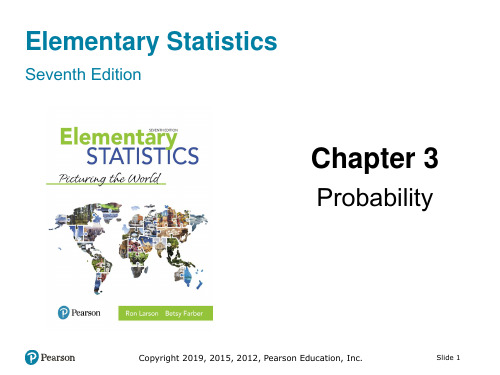
Slide 17
Example: Finding Probabilities (2 of 3)
Find the probability of being dealt 5 diamonds from a standard deck of 52 playing cards.
Solution In a standard deck of playing cards, 13 cards are diamonds. Note that it does not matter what order the cards are selected. The possible number of ways of choosing 5 diamonds out of 13 is 13C5.
Slide 7
Example: Finding presubscript n P subscript r (1 of 2)
Find the number of ways of forming four-digit codes in which no digit is repeated.
Solution:
• You need to select 4 digits from a group of 10
•
n 10, r 4
10
P4
10
10 4
10 6
10 9 8 7 6 6
5040 ways
Copyright 2019, 2015, 2012, Pearson Education, Inc.
Solution: The number of permutations is
9 9 8 7 6 5 4 3 2 1 362,880 ways
应用统计学英文课件 Business Statistics Ch03 Numerical Descriptive Measures
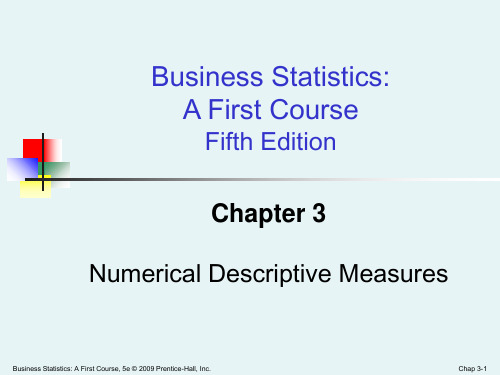
Chap 3-8
Measures of Central Tendency: Locating the Median
If the number of values is even, the median is the average of the two middle numbers
Note that n 1 is not the value of the median, 2
Chap 3-4
Measures of Central Tendency: The Mean
The arithmetic mean (often just called “mean”) is the most common measure of central tendency
Pronounced x-bar
7 8 9 10 11 12 Range = 12 - 7 = 5
7 8 9 10 11 12 Range = 12 - 7 = 5
▪ Sensitive to outliers
1,1,1,1,1,1,1,1,1,1,1,2,2,2,2,2,2,2,2,3,3,3,3,4,5
Range = 5 - 1 = 4
1,1,1,1,1,1,1,1,1,1,1,2,2,2,2,2,2,2,2,3,3,3,3,4,120
0 1 2 3 4 5 6 7 8 9 10
Mean = 4
123410 20 4
5
5
Chap 3-7
Measures of Central Tendency: Locating the Median
The location of the median when the values are in numerical order (smallest to largest):
《统计学基础(英文版·第7版)》教学课件les7e_ppt_08_01

▪ Independent Samples • The sample selected from one population is not related to the sample selected from the second population.
▪ Dependent Samples (paired or matched samples) • Each member of one sample corresponds to a member of the other sample.
.
Copyright 2019, 2015, 2012, Pearson Education, Inc.
10
Two Sample z-Test for the Difference Between Means
To perform a z-test for the difference between two population means μ1 and μ2 when the samples are independent, the following conditions are necessary.
• 8.4 Testing the Difference Between Proportions
.
Copyright 2019, 2015, 2012, Pearson Education, Inc.
2
Section 8.1
Testing the Difference Between Means (Independent Samples,
.
Copyright 2019, 2015, 2012, Pearson Education, Inc.
▪ Dependent Samples (paired or matched samples) • Each member of one sample corresponds to a member of the other sample.
.
Copyright 2019, 2015, 2012, Pearson Education, Inc.
10
Two Sample z-Test for the Difference Between Means
To perform a z-test for the difference between two population means μ1 and μ2 when the samples are independent, the following conditions are necessary.
• 8.4 Testing the Difference Between Proportions
.
Copyright 2019, 2015, 2012, Pearson Education, Inc.
2
Section 8.1
Testing the Difference Between Means (Independent Samples,
.
Copyright 2019, 2015, 2012, Pearson Education, Inc.
戴维商务统计学第7版英文版教学课件BSFC7e_CH11

χ
2 STAT
for
the 2 x c casehas (2 - 1)(c - 1) c - 1 degreesof
freedom
(Assumed: each cell in the contingency table has expected frequency of at least 1)
Chapter 11
Chi-Square Tests
Copyright © 2016, 2013, 2010 Pearson Education, Inc.
Chapter 11, Slide 1
Objectives
In this chapter, you learn:
▪ How and when to use the chi-square test for
Decision Rule
DCOVA
The χ S2TATtest statistic approximately follows a chisquared distribution with one degree of freedom
Decision Rule:
If
χ
2 STAT
χ
2 α
,
reject
▪ Suppose we examine a sample of 300 children
DCOVA
Copyright © 2016, 2013, 2010 Pearson Education, Inc.
Chapter 11, Slide 4
Contingency Table Example
(continued)
H0,
otherwise, do not reject
戴维商务统计学第7版英文版教学课件BSFC7e_CH01
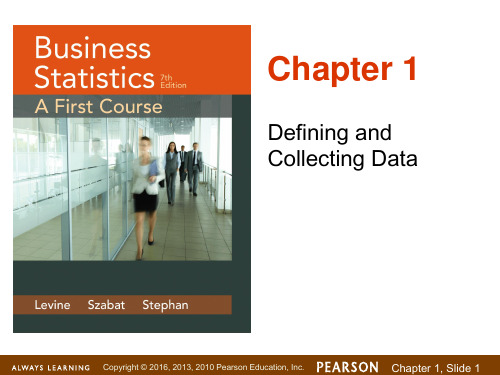
Chapter 1, Slide 5
Collecting Data Correctly Is A ritical
Task
DCOVA
▪ Need to avoid data flawed by biases, ambiguities, or other types of errors.
▪ Results from flawed data will be suspect or in error.
DCOVA
▪ A marketing research analyst needs to assess the effectiveness of a new television advertisement.
▪ A pharmaceutical manufacturer needs to determine whether a new drug is more effective than those currently in use.
Sources of data fall into five categories
DCOVA
Data distributed by an organization or an individual
The outcomes of a designed experiment
The responses from a survey
▪ An auditor wants to review the financial transactions of a company in order to determine whether the company is in compliance with generally accepted accounting principles.
《统计学基础(英文版·第7版)》教学课件les7e_ppt_04_03

12
Solution: Finding a Poisson Probability Using a Table
According to the table, the probability is 0.0425. You can check this result using technology. As shown below using Excel, the probability is 0.042484. After rounding to four decimal places, the probability is 0.0425, which is the same value found using the table.
Chapter 4
Discrete Probability Distributions
Copyright 2019, 2015, 2012, Pearson Education, Inc.
1
Chapter Outline
• 4.1 Probability Distributions • 4.2 Binomial Distributions • 4.3 More Discrete Probability Distributions
.
Copyright 2019, 2015, 2012, Pearson Education, Inc.
11
Solution: Finding a Poisson Probability Using a Table
Solution: A portion of Table 3 in Appendix B is shown here.
The mean number of accidents per month at a certain intersection is 3. What is the probability that in any given month four accidents will occur at this intersection?
《统计学基础(英文版·第7版)》课件les7e_ppt_ADA_1102
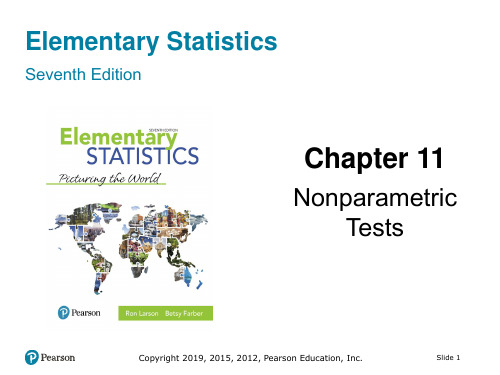
A golf club manufacturer claims that golfers can lower their scores by using the manufacturer’s newly designed golf clubs. The table shows the scores of 10 golfers while using the old design and while using
Copyright 2019, 2015, 2012, Pearson Education, Inc.ilcoxon Signed-Rank Test (1 of 4)
In Words
In Symbols
1. Verify that the samples are random and dependent.
Slide 11
Solution: Performing a Wilcoxon Signed-Rank Test (2 of 3)
• From Table 9 in Appendix B, the critical value is 8. To find the test statistic ws , complete a table as shown below.
Elementary Statistics
Seventh Edition
Chapter 11
Nonparametric Tests
Copyright 2019, 2015, 2012, Pearson Education, Inc.
Slide 1
Chapter Outline
• 11.1 The Sign Test • 11.2 The Wilcoxon Tests • 11.3 The Kruskal-Wallis Test • 11.4 Rank Correlation • 11.5 The Runs Test
统计学课件英语

1
Financial Accounting and Accounting Standards
LEARNING OBJECTIVES
After studying this chapter, you should be able to: 1. Identify the major financial statements and other means of financial reporting. 2. Explain how accounting assists in the efficient use of scarce resources. 3. Identify the objective of financial reporting. 4. Explain the need for accounting standards. 5. Identify the major policy-setting bodies and their role in the standard-setting process.
in making decisions in their capacity as capital providers.
Illustration 1-1 Capital Allocation Process
It promotes productivity, encourages innovation, and provides an efficient and liquid market for buying and selling securities and obtaining and granting credit.
1-6
LO 2 Explain how accounting assists in the efficient use of scare resources.
英文商务统计学ppt课件第一章_Ch01
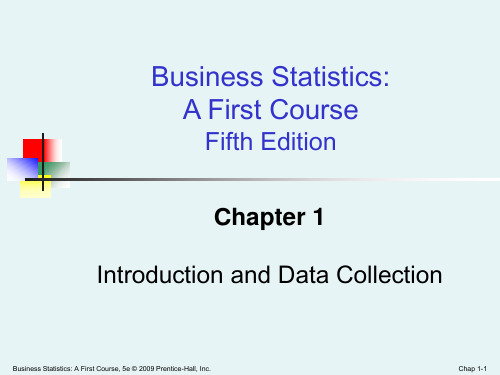
A marketing research analyst needs to assess the effectiveness of a new television advertisement. A pharmaceutical manufacturer needs to determine whether a new drug is more effective than those currently in use. An operations manager wants to monitor a manufacturing process to find out whether the quality of the product being manufactured is conforming to company standards. An auditor wants to review the financial transactions of a company in order to determine whether the company is in compliance with generally accepted accounting principles.
e.g., Estimate the population mean weight using the sample mean weight e.g., Test the claim that the population mean weight is 120 pounds
Hypothesis testing
Business Statistics: A First Course, 5e © 2009 Prentice-Hall, Inc.
基础统计学英文课件 (8)

population mean • Determine the minimum sample size required when
estimating μ
Point Estimate for Population μ
Point Estimate • A single value estimate for a population parameter • Most unbiased point estimate of the population mean
Level of Confidence
• If the level of confidence is 90%, this means that we are 90% confident that the interval contains the population mean μ.
c = 0.90
Margin of error
• The greatest possible distance between the point estimate and the value of the parameter it is estimating for a given level of confidence, c.
Solution: Finding the Margin of Error
• First find the critical values
0.95
0.025
0.025
z
-zc = -1z.c96 z = 0 zczc= 1.96
95% of the area under the standard normal curve falls within 1.96 standard deviations of the mean. (You can approximate the distribution of the sample means with a normal curve by the Central Limit Theorem, because n ≥ 30.)
estimating μ
Point Estimate for Population μ
Point Estimate • A single value estimate for a population parameter • Most unbiased point estimate of the population mean
Level of Confidence
• If the level of confidence is 90%, this means that we are 90% confident that the interval contains the population mean μ.
c = 0.90
Margin of error
• The greatest possible distance between the point estimate and the value of the parameter it is estimating for a given level of confidence, c.
Solution: Finding the Margin of Error
• First find the critical values
0.95
0.025
0.025
z
-zc = -1z.c96 z = 0 zczc= 1.96
95% of the area under the standard normal curve falls within 1.96 standard deviations of the mean. (You can approximate the distribution of the sample means with a normal curve by the Central Limit Theorem, because n ≥ 30.)
基础统计学英文课件 (3)

Average that have share price increases on a given day.
Solution: Discrete random variable (The number of stocks whose share price increases can be counted.)
Score, x 1 2 3 4
Frequency, f 24 33 42 30
5
21
Solution: Constructing a Discrete Probability Distribution
• Divide the frequency of each score by the total
Solution: Continuous random variable (The amount of water can be any volume between 0 ounces and 32 ounces)
x
0 1 2 3 … 32
Discrete Probability Distributions
§ x = Number of sales calls a salesperson makes in one day.
x
0 12 345
Random Variables
Continuous Random Variable • Has an uncountable number of possible outcomes,
employees. Individuals were given a score from 1 to 5,
where 1 was extremely passive and 5 extremely
Solution: Discrete random variable (The number of stocks whose share price increases can be counted.)
Score, x 1 2 3 4
Frequency, f 24 33 42 30
5
21
Solution: Constructing a Discrete Probability Distribution
• Divide the frequency of each score by the total
Solution: Continuous random variable (The amount of water can be any volume between 0 ounces and 32 ounces)
x
0 1 2 3 … 32
Discrete Probability Distributions
§ x = Number of sales calls a salesperson makes in one day.
x
0 12 345
Random Variables
Continuous Random Variable • Has an uncountable number of possible outcomes,
employees. Individuals were given a score from 1 to 5,
where 1 was extremely passive and 5 extremely
统计学课件-英文版
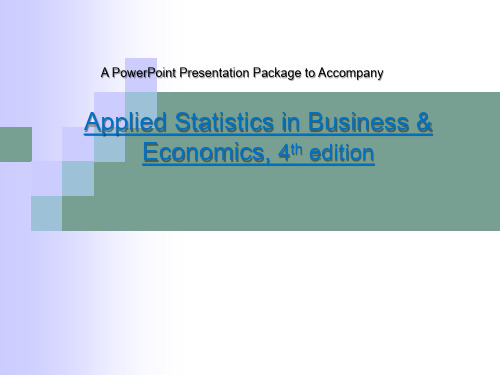
LO4-1: Explain the concepts of center, variability, and shape.
Three key characteristics of numerical data:
4-5
Chapter 4
LO4-2
4.1 Numerical Description
LO4-2: Use Excel to obtain descriptive statistics and visual displays.
•
For the J.D. Power quality data:
•
Here, the midrange (126.5) is higher than the mean (114.70) or median (113).
4-14
Chapter 4
LO4-3
4.2 Measures of Center
Growth Rates A variation on the geometric mean used to find the average growth rate for a time series.
4-12
Chapter 4
LO4-3
4.2 Measures of Center
Year Revenue (mil)
Formulas> Insert Function (������������ ) >Statistical>MEDIAN
4-9
Chapter 4
LO4-3 Mode
• • •
4.2 Measures of Center
The most frequently occurring data value. May have multiple modes or no mode. The mode is most useful for discrete or categorical data with only a few distinct data values. For continuous data or data with a wide range, the mode is rarely useful.
- 1、下载文档前请自行甄别文档内容的完整性,平台不提供额外的编辑、内容补充、找答案等附加服务。
- 2、"仅部分预览"的文档,不可在线预览部分如存在完整性等问题,可反馈申请退款(可完整预览的文档不适用该条件!)。
- 3、如文档侵犯您的权益,请联系客服反馈,我们会尽快为您处理(人工客服工作时间:9:00-18:30)。
5
Descriptive vs. Inferential Statistics
Descriptive statistics: involves arranging, summarizing, and presenting a set of data in such a way that useful information is produced. Its methods make use of graphical techniques and numerical descriptive measures (such as averages) to summarize and present the data Inferential statistics: generalizing from a sample to a population, estimating unknown population parameters, drawing conclusions, making decisions.
ቤተ መጻሕፍቲ ባይዱ13
Scale of Measurement: Ratio
The data have the properties of interval data and the ratio of two values is meaningful. Contains a meaningful zero value that indicates that nothing exists for the variable at the zero point .
15
Kinds of Data (variables)
Qualitative (Categorical) data:
• Indicate the presence or absence in a subject of a specific characteristic, such as Gender • Values are described by words rather than numbers, or numbers without math meanings.
“Statistics is a way to get information from data”
Statistics
Data Data: Facts, especially numerical facts, collected together for reference or information. Information Information: Knowledge communicated concerning some particular fact.
Information New information about the class.
Statistics is a tool for creating new understanding from a set of numbers, it gives us good descriptions about the object.
Inference
Parameter
Statistic
We can infer about a Population’s Parameters based on a Sample’s Statistics.
7
Data
Data: a set of observed values of a variable or variables Variable: generally a thing that can change, characteristic of an individual that takes on various values.
E.g., distance, height, weight, etc,.
14
Qualitative and Quantitative Data
Data can also be classified as being qualitative or quantitative. The statistical analysis that is appropriate depends on whether the data for the variable are qualitative or quantitative . In general, there are more alternatives for statistical analysis when the data are quantitative.
STATISTICAL ANALYSIS FOR BUS & ECON
Lesson 1: Introduction
Bin Wang
Statistical Analysis for Business & Economics: Spring 2011
What is Statistics?
Statistics is the science of collecting, organizing, analyzing, interpreting, and presenting data.
9
Scale of Measurement
Scales of measurement for a variable include: nominal, ordinal, interval, and ratio The scale determines the amount of information contained in the data. The scale indicates the data summarization and statistical analysis that are most appropriate.
Definitions: Oxford English Dictionary
3
Population vs. Sample
Population
• a population is the group of all items of interest to a statistics practitioner.
10
Scale of Measurement: Nominal
Data are labels or names used to identify an attribute of the element. A nonnumeric label or numeric code may be used. E.g., Students are classified by the school in which they are enrolled such as Business, Humanities, Education, etc,. Alternatively, a numeric code could be used for the school variable: 1 = Business, 2 = Humanities, 3 = Education, etc,.
11
Scale of Measurement: Ordinal
The data have the properties of nominal data and the order or rank of them is meaningful. A nonnumeric label or numeric code may be used. The difference of numeric code has no meaning. E.g., Repair service ratings: excellent, good, or poor. Alternatively, a numeric code could be used for the school variable: 1 = excellent, 2 = good, 3 = poor.
Statistics is a tool for creating new understanding from a set of numbers.
Definitions: Oxford English Dictionary
2
What is Statistics?
Statistics is the science of collecting, organizing, analyzing, interpreting, and presenting data.
“Statistics is a way to get information from data”
Statistics
Data List of last terms’ scores: 95, 82, 70, 54, 78, 69, 89,…
E.g. Class average, Proportion of class receiving A’s, Most frequent mark, Marks distribution, etc.
Q: the salaries of Indiana Pacers’ players in the last year? (population or sample?)
4
Key Statistical Concepts
Population Sample
Subset
Parameter
Population has Parameter,
Statistic
Sample has Statistic.
• A statistic is a single measure (number) used to summarize a sample data set.
Descriptive vs. Inferential Statistics
Descriptive statistics: involves arranging, summarizing, and presenting a set of data in such a way that useful information is produced. Its methods make use of graphical techniques and numerical descriptive measures (such as averages) to summarize and present the data Inferential statistics: generalizing from a sample to a population, estimating unknown population parameters, drawing conclusions, making decisions.
ቤተ መጻሕፍቲ ባይዱ13
Scale of Measurement: Ratio
The data have the properties of interval data and the ratio of two values is meaningful. Contains a meaningful zero value that indicates that nothing exists for the variable at the zero point .
15
Kinds of Data (variables)
Qualitative (Categorical) data:
• Indicate the presence or absence in a subject of a specific characteristic, such as Gender • Values are described by words rather than numbers, or numbers without math meanings.
“Statistics is a way to get information from data”
Statistics
Data Data: Facts, especially numerical facts, collected together for reference or information. Information Information: Knowledge communicated concerning some particular fact.
Information New information about the class.
Statistics is a tool for creating new understanding from a set of numbers, it gives us good descriptions about the object.
Inference
Parameter
Statistic
We can infer about a Population’s Parameters based on a Sample’s Statistics.
7
Data
Data: a set of observed values of a variable or variables Variable: generally a thing that can change, characteristic of an individual that takes on various values.
E.g., distance, height, weight, etc,.
14
Qualitative and Quantitative Data
Data can also be classified as being qualitative or quantitative. The statistical analysis that is appropriate depends on whether the data for the variable are qualitative or quantitative . In general, there are more alternatives for statistical analysis when the data are quantitative.
STATISTICAL ANALYSIS FOR BUS & ECON
Lesson 1: Introduction
Bin Wang
Statistical Analysis for Business & Economics: Spring 2011
What is Statistics?
Statistics is the science of collecting, organizing, analyzing, interpreting, and presenting data.
9
Scale of Measurement
Scales of measurement for a variable include: nominal, ordinal, interval, and ratio The scale determines the amount of information contained in the data. The scale indicates the data summarization and statistical analysis that are most appropriate.
Definitions: Oxford English Dictionary
3
Population vs. Sample
Population
• a population is the group of all items of interest to a statistics practitioner.
10
Scale of Measurement: Nominal
Data are labels or names used to identify an attribute of the element. A nonnumeric label or numeric code may be used. E.g., Students are classified by the school in which they are enrolled such as Business, Humanities, Education, etc,. Alternatively, a numeric code could be used for the school variable: 1 = Business, 2 = Humanities, 3 = Education, etc,.
11
Scale of Measurement: Ordinal
The data have the properties of nominal data and the order or rank of them is meaningful. A nonnumeric label or numeric code may be used. The difference of numeric code has no meaning. E.g., Repair service ratings: excellent, good, or poor. Alternatively, a numeric code could be used for the school variable: 1 = excellent, 2 = good, 3 = poor.
Statistics is a tool for creating new understanding from a set of numbers.
Definitions: Oxford English Dictionary
2
What is Statistics?
Statistics is the science of collecting, organizing, analyzing, interpreting, and presenting data.
“Statistics is a way to get information from data”
Statistics
Data List of last terms’ scores: 95, 82, 70, 54, 78, 69, 89,…
E.g. Class average, Proportion of class receiving A’s, Most frequent mark, Marks distribution, etc.
Q: the salaries of Indiana Pacers’ players in the last year? (population or sample?)
4
Key Statistical Concepts
Population Sample
Subset
Parameter
Population has Parameter,
Statistic
Sample has Statistic.
• A statistic is a single measure (number) used to summarize a sample data set.
